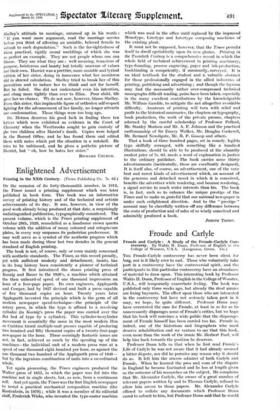Enlightened Advertisement
Printing in the X.Xth Century. (Times Publishing Co. 7s. 6d.)
ON the occasion of its forty-thousandth number, in 1912, the Times issued a printing supplement which was later published in book form. This book was an informative survey of printing history and of the technical and artistic achievements of its day. It was, however, in view of the good work already being produced at that date, a Surprisingly undistinguished publication, typographically considered. The present volume, which is the Times printing supplement of October 29th, 1929, remodelled as a handsome crown quarto volume with the addition of many coloured and rotogravure plates, in every way surpasses its pedestrian predecessor. It may well serve as a symbol of the aesthetic progress which has been made during these last -two decades in the general
standard.of English printing. • - -
The book is not, of course, only or even mainly concerned with aesthetic standards. The Times, as this record proudly, yet with sufficient Modesty and detaclunent, insists, has in its long history been consistently a pioneer of technical progress. It first introduced the steam printing press of Koenig and Bauer in the 1820's, a machine which attained the then unheard-of speed of one thousand impressions an hour of a four-page paper. Its own engineers, Applegarth and Cowper, had by 1827 devised and built a press capable of five thousand copies an hour. Twenty years later Applegarth invented the principle which is the germ of all modern newspaper speed-technique—the principle of the rotary press, in which the type is affixed to a revolving cylinder (in Koenig's press the paper was carried over the fiat bed of type by a cylinder). This cylinder-to-cylinder movement is essentially the same in the most modern Hoe or Crabtiee tiered Multiple-unit presses capable of producing two hundred and-fifty thousand copies of a twenty-four-page newspaper in the hour. These seemingly fantastic issues are not, in fact, achieved so much by the speeding up of the machines—the individual unit of a modern press runs at a speed of one thousand eight hundred per hour, as against the one thousand two hundred of the Applegarth press of 1848— but by the ingenious combination of units into a co-ordinated whole.
Yet again pioneering, the Times engineers produced the Walter press of 1855, in which the paper was fed into the machine not in single sheets, but, as now, from a continuous roll. And yet again, the Times was the that English newspaper to instal a practical mechanical composition machine (the Kastenbein, in 1879) ; while it was a member of its editorial staff, Frederick Wicks, who invented the type-caster machine
which was used in the office until replaced by the improved Monotype, Linotype and Intertype composing machines of the existing plant.
It must not be supposed, however, that the Times permits itself to dwell egotistically upon its own glories.' Printing in the Twentieth Century is a comprehensive record in which the whole field of technical achievement in printing machinery; type-founding, process engraving; paper and ink-production, bookbinding is competently, if summarily, surveyed. It is
an ideal textbook for the student and fi valuable abstract for those professionally engaged in the allied industries of printing, publishing and advertising ; and though the layman may find the necessarily- rather over-compressed technical monographs difficult reading, pains have been taken, especially in the many excellent contributions by the knowledgeable Mr. William Gamble, to mitigate the not altogether avoidable difficulty. Amateurs of printing will turn with relief and profit to the historical summaries, the chapters on typography, book production, the work of the private presses, chapters adorned by the careful scholarship of Professor Pollard, Mr. Stanley Morison and Mr. A. F. Johnson and the practical carftsmanship of Sir Emery Walker, Mr. Douglas Cockerel!, Mr. Bernard Newdigate, Mr. R. P. Gossop and others.
That a book of three hundred pages, set in comely, legible type skilfully arranged, with something like a hundred illustrations, should be able to be produced at the absurdly modest price of 7s. 6d. needs a word of explanation in justice to the ordinary publisher. The book carries some thirty advertisements (incidentally, these are excellently designed). It is itself also, of course, an advertisement, one of the very best and rarest kinds of advertisement which, on account of the generous and detached mood in which it is conceived, benefits the advertiser, while rendering, and because rendering, a signal service to much wider interests than his. The book is, in fact, such as to enhance the unique prestige of the Times and to make us grateful that our national newspaper is under such enlightened direction. And to the " prestige " account may be cheerfully written off any difference between the costs of production and of sales of so wisely conceived and admirably produced a book.
JOSEPH THORP.


















































 Previous page
Previous page